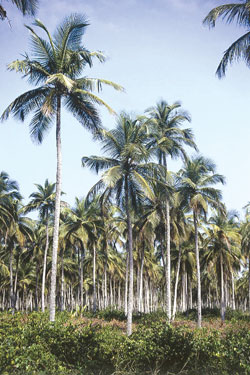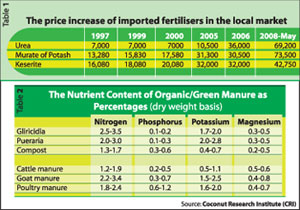Impact of contradictory policies on coconut production
Chandrasiri Nanayakkara
|

People cut down coconut trees for construction work
|
Year after year the coconut supply in the market for consumption as
well as for industries is reducing. The yield is going down. The total
nut production is not sufficient to cater to the demand. As a result
price increases, reduce the produce exports and discourage the
traditional and emerging coconut based industries with a lot of negative
externalities.
To increase the yield regular fertilising of the crop is compulsory.
On this, the cultivator is assisted by giving a subsidy of Rs. 7,000 per
ton of fertiliser by the Government. This scheme is implemented through
Coconut Cultivation Board (CCB) whose mandate is to develop the coconut
cultivation mobilising its field staff.
In Sri Lanka the most neglected crop is coconut. This is true with
the home gardens, small holdings as well as large estates. Though the
gross acreage under coconut is rerecorded as 1,093,197 acres in 2002 the
net acreage is decreasing drastically. The reasons are, environmental,
physiological, managerial and destruction by man.
Since last year issue of fertiliser for coconut is taken over by the
CCB. In 2007 they were able to distribute only 10,000 tonnes. In 2003 it
was 38,958 tonnes, a reduction of 75%. The increase of prices of
imported fertilisers is also another factor facing the grower. The
prices increased from 1996 to 2008 is as follows. (See table 1)
The price of urea in the year 2005 was Rs. 10,500 and increased to Rs.
62,200 per tonne in 2008, an increase of 492%. This is unavoidable
because we import it but we have to find local substitutes. For MoP we
have little or no locally available substitutes.
But for urea there are a lot of substitutes and are of animal and
plant origin. The excreta of farm animals such as cow dung, goat dung,
poultry droppings are animal origin.
One can say that this is bulky and need to transport from animal
husbandry farms at a cost. Then we have to consider the plant originated
ones such as green manure which could be cultivated in the land itself.
The most suitable ones are Gliricidia and Pueraria.
The nutrient contents of some organic manure are as follows. (See
table 2) This analysis of nutrients shows that all the organic/green
manure are rich in nitrogen. Hence we can partially or completely
substitute urea which is the artificial source of nitrogen mainly using
Gliricidia, Pueraria and compost produced in situ with least cost. It is
recommended that 20-30 kg of above items per palm could substitute urea
completely.
The above organic/green manure increases the microbes in the soil,
loosens and makes it friable, increases the water holding capacity and
releases nutrients slowly. The urea is a pollutant of soil and waterways
but green manure plants create a micro climate and improve the
environment.
The Gliricidia could be grown as live fences, along road sides and
open spaces. Considering its advantages the Government has declared
Gliricidia as a new plantation crop and a subsidy is given by through
the CCB to cultivate it in coconut lands. Pueraria is a vigorous creeper
that covers the entire land surface and is recommended by the CRI.
 What is the success of fertiliser distribution by CCB in 2007? The
CCB has become the monopoly of issuing the fertiliser. In 2007, it
reduced the quantity applied by 75%. Has it facilitated the timely
application? Has it made the purchasing process easier to cultivators? What is the success of fertiliser distribution by CCB in 2007? The
CCB has become the monopoly of issuing the fertiliser. In 2007, it
reduced the quantity applied by 75%. Has it facilitated the timely
application? Has it made the purchasing process easier to cultivators?
Are they having enough vehicles to transport regional fertiliser,
stores to store and have enough manpower to handle this trade? Are they
ready to supply fertiliser for Yala 2008 (now it is May)? Answers to all
these are negative.
The Yala rains are subsiding. Though the CCB is issuing permits they
do not have fertiliser with them. They do not know when they could issue
fertiliser for this year. They have no idea of prices.
While encouraging the planting of green manures to substitute urea,
the CCB made it compulsory to buy urea with other fertilisers on the
recommended ratio. Otherwise the growers are not entitled for the
subsidy. At the same time it offers subsidy to grow Gliricidia in
plantations. This is a contradictory policy situation. Are they
discouraging the use of organic manures and force the grower to buy urea
at a high cost?
The Mahinda Chintanaya encourages more and more use of organic and
green manure to enrich our soils and discourage the use of urea, which
is a pollutant. To save foreign exchange in a situation of escalating
urea price we have to promote more and more use of organic manure.
The grower does not know that the delay in issue of fertiliser for
2008 is due to red tapes of the treasury, Plantation Ministry or CCB in
this crisis situation of short supply of coconut.
What are the short and long term impacts of all these? It adds
another factor to discourage the grower and reduce coconut production
further down in the future.
The policies are formulated and implemented to improve or sustain (at
least) the current situation. They should contribute to the development
of the sector.
If expected results are not realised after implementation of
policies, those policies should be corrected before further damage is
done. Hence these suggestions should be considered for future policy
changes for the sake of the coconut sector.
* Revise the subsidy on the basis of proportionate increase of
fertiliser prices.
* Let the CCB handle the activities in the field on cultivation
rather than involve in fertiliser trade.
* Allow the fertiliser traders to handle their business competitively
and efficiently and rectify any malpractices.
* Draw special attention by the CCB to promote green manure
production in coconut plantations. (The writer is an Agricultural
Economist and a member of the Coconut Growers' Association) |

